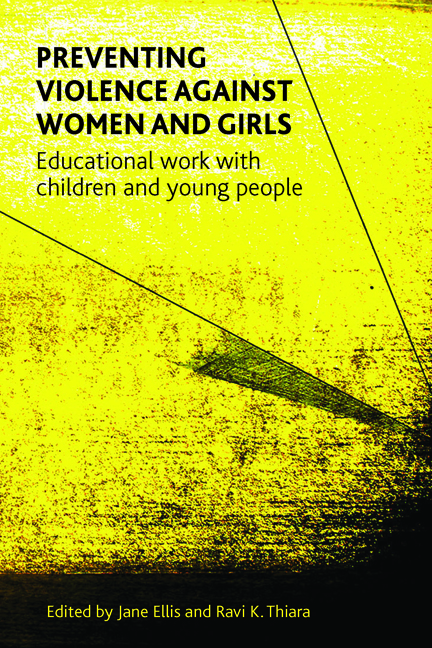Book contents
- Frontmatter
- Dedication
- Contents
- List of tables and figures
- Notes on contributors
- Acknowledgements
- Foreword
- Introduction
- one Preventing violence against women and girls through education: dilemmas and challenges
- two Does gender matter in violence prevention programmes?
- three Responding to sexual violence in girls’ intimate relationships: the role of schools
- four ‘Pandora’s Box’: preventing violence against black and minority ethnic women and girls
- five Preventing violence against women and girls: a whole school approach
- six What did you learn at school today? Education for prevention
- seven No silent witnesses: strategies in schools to empower and support disclosure
- eight Preventing sexual violence: the role of the voluntary sector
- nine ‘Boys think girls are toys’: sexual exploitation and young people
- ten MsUnderstood: the benefits of engaging young women in antiviolence work
- eleven Shifting Boundaries: lessons on relationships for students in middle school
- Concluding remarks
- Appendix: Examples of programmes in the UK
- Index
two - Does gender matter in violence prevention programmes?
Published online by Cambridge University Press: 04 March 2022
- Frontmatter
- Dedication
- Contents
- List of tables and figures
- Notes on contributors
- Acknowledgements
- Foreword
- Introduction
- one Preventing violence against women and girls through education: dilemmas and challenges
- two Does gender matter in violence prevention programmes?
- three Responding to sexual violence in girls’ intimate relationships: the role of schools
- four ‘Pandora’s Box’: preventing violence against black and minority ethnic women and girls
- five Preventing violence against women and girls: a whole school approach
- six What did you learn at school today? Education for prevention
- seven No silent witnesses: strategies in schools to empower and support disclosure
- eight Preventing sexual violence: the role of the voluntary sector
- nine ‘Boys think girls are toys’: sexual exploitation and young people
- ten MsUnderstood: the benefits of engaging young women in antiviolence work
- eleven Shifting Boundaries: lessons on relationships for students in middle school
- Concluding remarks
- Appendix: Examples of programmes in the UK
- Index
Summary
All children, young people and adults can be the targets of violence, the most likely perpetrators being family members, intimate partners or acquaintances. No one deserves such abuse and we must continue to explore ways to prevent all violence. Nonetheless, it is critical to acknowledge that girls and women are the primary targets of many forms of abuse, including child sexual abuse, dating violence, intimate partner violence, sexual assault, and sexual harassment (Heise et al, 2002). Such forms of violence are defined as ‘gender-based’, occurring in private (as in abuse in families and intimate relationships) and public spheres (school, community).
What causes gender-based violence? While several authors have adopted a multi-levelled, ecological view of the etiology of such violence (Heise et al, 2002), one significant cause within this is a power imbalance related to male authority and privilege (Morrison et al, 2007). Gender-based violence is particularly evident when societal attitudes, behaviours and institutions uphold traditional male power. The fear of violence experienced by many women and girls tends only to reinforce the gender inequality in society; reinforcing a sense of powerlessness and limiting the effective functioning of girls and young women in both private and public realms (Berman et al, 2002).
School-based violence prevention programmes are one important way to inform, address and provide strategies to intervene so that violence either does not occur or its effects are minimised. Developed in the past 30 years, a proliferation of prevention programmes address school violence, bullying, sexual abuse, dating violence, discrimination, sexual harassment, sexual assault and the sexual exploitation of children and young people (Tutty et al, 2005).
Drawing on the Canadian experience, this chapter explores the role and importance of a gendered framework in preventing violence against women and girls. In so doing it presents sections on school-based programmes addressing the prevention of child sexual abuse, bullying, sexual harassment, dating violence and, briefly, sexual assault, examining the gendered aspects of each. Although many programmes cite such gendered violence as a core principle, the extent to which this is explicit in the programme materials varies. The chapter discusses some of the challenges of adopting a gendered approach and strategies to address this in gaining entry to the school system.
One approach to highlight the gendered nature of intimate violence is administering the programme or parts of the programme in separate gender groups.
- Type
- Chapter
- Information
- Preventing Violence against Women and GirlsEducational Work with Children and Young People, pp. 45 - 64Publisher: Bristol University PressPrint publication year: 2014



